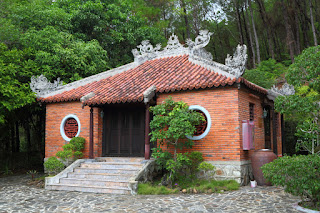Hue is considered as one of the most significant cultural and historic centers in Vietnam, and this is part 2 of our blog covering a long weekend spent in this beautiful city.
The first day had been spent exploring the Imperial City. This blog covers days two and three, and the various tombs, pagodas, temples and museums that we visited.
The tombs of the Nguyen Emperors are considered to be some of the areas most fascinating attractions. We visited the tombs of Tu Duc, Khai Dinh and Minh Mang. But before arriving at the tombs, we started with a visit to the Huyen Tran Princess Temple.
The tombs of the Nguyen Emperors are considered to be some of the areas most fascinating attractions. We visited the tombs of Tu Duc, Khai Dinh and Minh Mang. But before arriving at the tombs, we started with a visit to the Huyen Tran Princess Temple.
The Huyen Tran Princess Temple is a large complex consisting of sprawling gardens, temples, a statue of Maitreya, a bell tower, and various carvings. We thoroughly enjoyed the quiet surroundings and the overall sense of peace at this complex.
Maitreya, regarded as the future Buddha of this world in Buddhism
The bell tower, where the resident monk gave us a lesson on how to ring the bell
The long path leading up to the bell tower
After the Huyen Tran Princess Temple, the first tomb that we visited was Khai Dinh Tomb. It was built between 1920 and 1931, and is considered the least traditional tomb because of the use of concrete and the combination of European and Vietnamese styles. What we liked most about it: the warrior statues!
After Khai Dinh Tomb we then headed on to Tu Duc Tomb. This complex has adopted a far more traditional building style and is surrounded by trees and lotus ponds.
And the final tomb that we visited was Minh Mang Tomb. This is another large complex with a traditional architectural style. What we really enjoyed about visiting all of these tombs was how well looked after they are and how quiet they all were, even on a long weekend.
The Perfume River runs through the center of Hue and features in local songs, poems and literature. One way of seeing the river up close is to take a cruise on a dragon boat. Although we decided to skip the cruise, we did enjoy watching the boats with their brightly painted dragon heads come past.
And of course there is also the occasional fisherman.
One of the popular pagodas to visit in Hue is Thien Mu Pagoda. Founded in 1601, the main feature is the seven-story octagonal tower.
An old Austin is housed in a garage at the back of the temple. This is the car that the monk Thich Quang Duc used to get to Saigon in June 1963, where he then set himself alight in protest against the oppressive regime at the time.
From Thien Mu Pagoda we then continued on to the Temple of Literature. The entrance to this temple is away from the main road and we would not have found it if it wasn't for a friendly guard that saw us standing at the locked main gate and then showed us the way in - for those visiting the temple and wondering where the entrance is, head about 50m back towards Thien Mu Pagoda until you reach a driveway, head up the driveway, and then look for a gap in the fence.
We also managed to find some time to visit the Royal Antiquities Museum. This museum is definitely worth visiting if you have time. Its not a big museum, but its a beautiful building with some lovely pieces.
And some photos from walks along the river
And more of that delicious food that Hue is famous for.
Yip, we think there is a lot to love about Hue and that it is definitely worth visiting.















































































